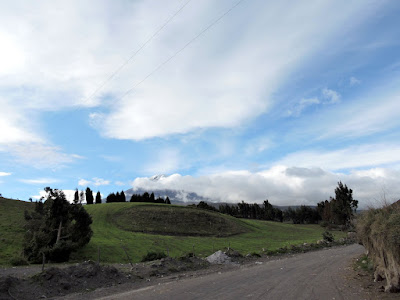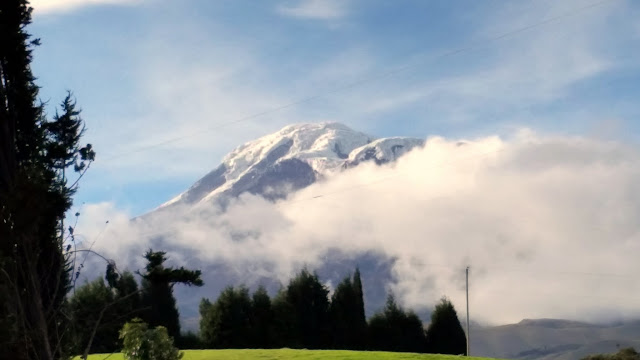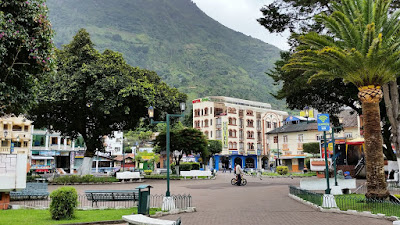As the three of us said goodbye to Banos-Ambato, we headed southward as we continued along the Avenue of the Volcanoes, and made our way to Chimborazo. The scenery continued to be spectacular. Milton educated us on the various indigenous groups, their history, and how to identify the distinctive groups by their dress.
Last summer, friends of mine from Cuenca traveled with visiting family members to Chimborazo. From the description of their visit, this mountain became of interest to me. My friends had described the area they visited as a moonscape. Unlike the currently active volcanoes of Pichincha and Tungurahua, Chimborazo is a dormant volcano. It is believed that it hasn't been active since about 550 a.d. Chimborazo's claim to fame is the fact that it, at one time, was believed to be the tallest mountain in the world. Today, it is considered to be the farthest point on the Earth's surface from the Earth's core, which is 6,384.4 km or 3,967.1 miles. This is partly due to the earth's bulge at the Equator, which also makes
Chimborazo the closest point on planet Earth to the sun. Since elevation begins at sea level, Chimborazo is 6,384.4 km or 20,564 ft. above sea level, which does not even make it the highest peak in the Andes.*
THE UNVEILING OF CHIMBORAZO
THE UNVEILING OF CHIMBORAZO

As we drove through Riobamba, the closest city to the Chimborazo National Park, the mountain was shrouded in clouds. It is not uncommon for tourists to see little more than clouds encompassing the mountain peak if not the entire mountain; and consider themselves lucky when they experience even partial openings of the peak among the clouds.
Seeing the peak in all of its magnificent glory is a most blessed event. As we continued our drive through Riobamba, the clouds began to partially separate, and gave us a gradually larger glimpses of the mountain. As we angled through the city more of the mountain became increasingly visible to us.
The city of Riobamba (below) with Chimborazo in the background:
As if on cue, in less than an hour; the entire peak became a feast for the eyes, as the winds wisped away the final mantle of clouds.
We were no longer hoping for glimpses, but viewing Chimborazo in it's full-specter glory.
By the time we left Riobamba, the sun was setting, and Chimborazo was dressed in the sun-drenched beauty of its absolute splendor.
I would strongly encourage you, if you are to visit overnight in or near Chimborazo; that if you can, make reservations to spend the night lodging on the slopes of the volcano by staying at Lodge Estrella del (Lodge of the Stars). After a photo-fest of taking pictures of the mountain, we drove out of the city of Riobamba into an isolated wilderness that was on the final stretch of road before entering the national park as we arrived at the lodge. For many mountain climbers, the lodge is where their trek begins.
It was very cold. That evening, as we settled into our cabins, it was as if we had left the entire world behind us. The feeling of isolation was enormous, and yet comforting. Walking from the restaurant to our cabins, we were enraptured by the piercing blackness of the dome above us, which contained more stars than we may have ever seen in our lives, as the three of us were silhouetted against the night sky.
Marc, once knew all the constellations when he was in the fourth grade. It appeared all of them were present that evening. We recognized the constellations we knew, and spotted what we thought were others, even when we weren't sure of their names. It was even more impressive, when an Ecuadorian like Milton was so moved by the spectacle above us, and had never before seen anything like it. I did not think to ask if the stars appeared in such celestial glory every night, or were we most fortunate to be at the lodge on such a clear night?
The night air was crisp. The surroundings so utterly silent. I never expected that this evening and the next day; Chimborazo was going to etch such an indelible imprint of an experience upon my memory, in my consciousness, and in my heart. An imprint that I believe will endure for the rest of my life.
The three of us entered the lodge restaurant to a very substantial and hearty Ecuadorian meal. With the cold outside, I never appreciated Ecuadorian soup more than I did that evening, and breakfast was just as good the next day.

These are photos of our cabin. These are the cabins. Believe me, we were truly isolated. Hardly anyone was occupying the cabins the night we were there. Each cabin had about four rooms on each floor.
Our room with two beds shared a common bathroom with another room across from our room. When we first arrived, the rooms were very cold. We turned on the electric heater which was made of some kind of molded plastic, and looked like the old fashion radiator heaters that were dependent upon coal to produce the steam and heat. Within an hour, we were relatively toasty. The bathrooms were not heated. However, I was surprised that it was no big deal to shower, and prepare for the day, and not feel terribly cold. The water for the shower and sink was very hot. No problem there.
The bedding included a very thick and warm comforter, which more than provided enough warmth for the night. It supplemented the electric heater perfectly. I slept really well, ensconced in the sounds of the endless wind.
Like the night before, the three of us made our way to the main building to the restaurant for breakfast, with Chimborazo as our constant companion.
It is at 18,000 ft, just 2,000 feet higher than the three of us were, that the ice and snow cap of the glacier is first experienced by climbers. Most climbers will begin their assent at 1:00 a.m. in the morning. Once the sun shines, the melting ice and snow can cause avalanches; and slick ice known as black ice can play havoc with the safety of the climbers. Chimborazo is a treacherous climb, and most climbers who attempt it do not endure the climb to the top.
When my friends visited the area last July, the vicinity was covered in snow. As you can see, there was no snow while we were there. The fellow at the refuge said there was no particular season for snow. It could come at anytime. We could see llama, alpaca, and vicuna at very close range; which dieted on paramo or tundra-type grasses, in a area above the timber line, and below the glacier line.
Notice below how desolate and stark the landscape is. Nothing like the lush greenery of Banos-Abato, and yet it has a beauty all of its own that needs to be experienced.
The vicuna (above) are much smaller than their llama and alpaca cousins. Their fur is so soft and silky feeling that just a square yard is worth thousands of dollars. The vicuna are not indigenous to Ecuador, but were brought to the country from Peru some decades ago, when they were almost extinct. Now they are a striving species.

These are photos of our cabin. These are the cabins. Believe me, we were truly isolated. Hardly anyone was occupying the cabins the night we were there. Each cabin had about four rooms on each floor.
Like the night before, the three of us made our way to the main building to the restaurant for breakfast, with Chimborazo as our constant companion.
It is at 18,000 ft, just 2,000 feet higher than the three of us were, that the ice and snow cap of the glacier is first experienced by climbers. Most climbers will begin their assent at 1:00 a.m. in the morning. Once the sun shines, the melting ice and snow can cause avalanches; and slick ice known as black ice can play havoc with the safety of the climbers. Chimborazo is a treacherous climb, and most climbers who attempt it do not endure the climb to the top.
When my friends visited the area last July, the vicinity was covered in snow. As you can see, there was no snow while we were there. The fellow at the refuge said there was no particular season for snow. It could come at anytime. We could see llama, alpaca, and vicuna at very close range; which dieted on paramo or tundra-type grasses, in a area above the timber line, and below the glacier line.
Notice below how desolate and stark the landscape is. Nothing like the lush greenery of Banos-Abato, and yet it has a beauty all of its own that needs to be experienced.
The vicuna (above) are much smaller than their llama and alpaca cousins. Their fur is so soft and silky feeling that just a square yard is worth thousands of dollars. The vicuna are not indigenous to Ecuador, but were brought to the country from Peru some decades ago, when they were almost extinct. Now they are a striving species.
Senor Milton looking chevere (cool).
The Molas
I stayed behind at the first refuge. Except for about ten minutes, I sat outside to enjoy the utterly beautiful and sunny day, until I couldn't take the cold any longer. Otherwise I spent my time inside; snacking, conversing, and napping. Two hours later, Marc and Milton returned. I think this was the highlight of Marc's travel in Ecuador. There was such a smile of satisfaction and quiet exhilaration on his face. This was truly a moment he would cherish.
For me Chimborazo was an awesome experience, and I took it as far as I could. For many a mountain climber, the challenge still laid ahead. Two thousand feet to the glacier line, and another 2,000 feet to Chimborazo's pinnacle (20,702 ft/6310 m) to climb Ecuador's highest peak. I hated to say goodbye to Chimborazo as much as I did to Banos/Ambato. I wondered if I would ever return, and I wondered if I would want to. How could I ever experience it under such optimal conditions again. Now it was onward to the town of Alausi and the Devil's Nose Train; and finally, Ingapirca which beckoned to us as we continued our trek southward to Cuenca.
*POSTSCRIPT
Some readers have questioned the statistics of measurement I used in the above account. Here is some data available from Wikpedia to better understand Chimboraso's elevation and why it is considered to be the highest point from the earth's center:
Farthest point from Earth's center[edit]
The summit of Mount Everest reaches a higher elevation above sea level, but the summit of Chimborazo is widely reported to be the farthest point on the surface from Earth's center,[12][13] with Huascarán a very close second. The summit of the Chimborazo is the fixed point on Earth which has the utmost distance from the center – because of the oblate spheroid shape of the planet Earth which is "thicker" around the Equator than measured around the poles.[note 3] Chimborazo is one degree south of the Equator and the Earth's diameter at the Equator is greater than at the latitude of Everest (8,848 m (29,029 ft) above sea level), nearly 27.6° north, with sea level also elevated. Despite being 2,580 m (8,465 ft) lower in elevation above sea level, it is 6,384.4 km (3,967.1 mi) from the Earth's center, 2,168 m (7,113 ft) farther than the summit of Everest (6,382.3 km (3,965.8 mi) from the Earth's center).[note 4] However, by the criterion of elevation above sea level, Chimborazo is not even the highest peak of the Andes.
The highest point on Chimborazo is the farthest point from the center of the earth, thus it is also the point on the earth's surface which is at some time closer to the sun than any other point on the earths surface at any time during one year. Chimborazo is the farthest point from the center of the earth because the earth bulges out at the equator and Chimborazo is located just one degree south of the equator. Mount Everest is 28° north of the equator. This is why Chimborazo is 2.1 kilometres farther from the earth's center than Everest. Chimborazo is 73.5 metres higher than the highest mountain in North America. Chimborazo is often associated with the nearby volcano Cotopaxi although the two volcanoes have completely different structures.






























































